|
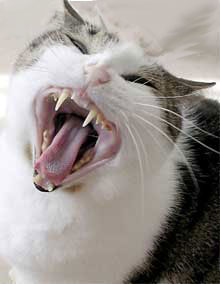 Killer Cats: Much like the big cats, domestic cats are very effective predators. They ambush and immobilize vertebrate prey using tactics similar to those of leopards and tigers by pouncing; then they deliver a lethal neck bite with their long canine teeth that severs the victim's spinal cord, causes fatal bleeding by puncturing the carotid artery or the jugular vein, or asphyxiates it by crushing its trachea. The domestic cat can hunt and eat about one thousand species, many of them invertebrates, especially insects — many big cats will eat fewer than 100. Although, theoretically, big cats can kill most of these species as well, they often do not due to the relatively low nutritional content that smaller animals provide for the effort. An exception is the leopard, which commonly hunts rabbits and many other smaller animals. Killer Cats: Much like the big cats, domestic cats are very effective predators. They ambush and immobilize vertebrate prey using tactics similar to those of leopards and tigers by pouncing; then they deliver a lethal neck bite with their long canine teeth that severs the victim's spinal cord, causes fatal bleeding by puncturing the carotid artery or the jugular vein, or asphyxiates it by crushing its trachea. The domestic cat can hunt and eat about one thousand species, many of them invertebrates, especially insects — many big cats will eat fewer than 100. Although, theoretically, big cats can kill most of these species as well, they often do not due to the relatively low nutritional content that smaller animals provide for the effort. An exception is the leopard, which commonly hunts rabbits and many other smaller animals.
Animal Trophy: Even well-fed domestic cats hunt and kill birds, mice, rats, scorpions, cockroaches, grasshoppers, and other small animals in the vicinity. They often present such trophies to their owners. The motivation is not entirely clear, but friendly bonding behaviors are often associated with such an action. It is probable that cats in this situation expect to be praised for their symbolic contribution to the group. Some theories suggest that cats see their owners gone for long times of the day and assume they are out hunting, as they always have plenty of food available. It is thought that a cat presenting its owner with a dead animal thinks it's 'helping out' by bringing home the kill. Ethologist Paul Leyhausen, in an extensive study of social and predatory behavior in domestic cats (documented in his book Cat Behavior), proposed a mechanism which explains this presenting behavior. In simple terms, cats adopt humans into their social group, and share excess kill with others in the group according to the local pecking order, in which humans place at or near the top.
Due to their hunting behavior, in many countries feral cats are considered pests. Domestic cats are occasionally also required to have contained cat runs or to be kept inside entirely, as they can be hazardous to locally endangered bird species. For instance, various municipalities in Australia have enacted 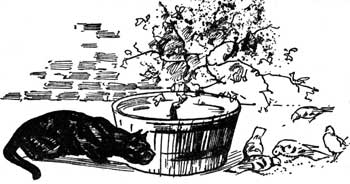 such legislation. In some localities, owners fit their cat with a bell in order to warn prey of its approach. Sometimes, such legislation. In some localities, owners fit their cat with a bell in order to warn prey of its approach. Sometimes,
the bell has the unwanted effect
of "training" the
cat to be an
even stealthier killer.
The All Meat Diet: Cats have highly specialized teeth and a digestive tract suitable to the digestion of meat. The premolar and first molar together compose the carnassial pair on each side of the mouth, which efficiently functions to shear meat like a pair of scissors. While this is present in canines, it is highly developed in felines. The cat's tongue has sharp spines, or papillae, useful for retaining and ripping flesh from a carcass. These papillae 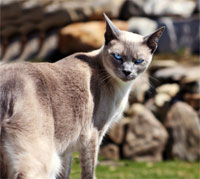 are small backward-facing hooks that contain keratin and assist in their grooming. Domesticated cats eat fairly little vegetable matter. It is quite common, however, for cats to occasionally supplement their carnivorous diets with small amounts of grass or other plant matter to help their digestive tract. Whereas bears and dogs commonly supplement their diet of meat with fruits, berries, roots, and honey when they can get them, cats prefer to mostly feed on meat. All felines, including the big cats, have a genetic anomaly that prevents them from tasting sweetness, which, more than likely, is related to their meat-dominated eating habits, and almost certainly related to their aversion to fruits and berries. However, many domesticated cats are known to like vegetables. The majority of brand-name cat foods are primarily meat based, but often contain large amounts of corn or rice and supplemented with meat byproducts and minerals and vitamins. Cats are also known to munch on grass, leaves, shrubs and houseplants to facilitate regurgitation of whatever may be upsetting their digestion. are small backward-facing hooks that contain keratin and assist in their grooming. Domesticated cats eat fairly little vegetable matter. It is quite common, however, for cats to occasionally supplement their carnivorous diets with small amounts of grass or other plant matter to help their digestive tract. Whereas bears and dogs commonly supplement their diet of meat with fruits, berries, roots, and honey when they can get them, cats prefer to mostly feed on meat. All felines, including the big cats, have a genetic anomaly that prevents them from tasting sweetness, which, more than likely, is related to their meat-dominated eating habits, and almost certainly related to their aversion to fruits and berries. However, many domesticated cats are known to like vegetables. The majority of brand-name cat foods are primarily meat based, but often contain large amounts of corn or rice and supplemented with meat byproducts and minerals and vitamins. Cats are also known to munch on grass, leaves, shrubs and houseplants to facilitate regurgitation of whatever may be upsetting their digestion.
Cats are obligate carnivores, and cannot live on an unsupplemented vegetarian diet because they cannot synthesize several required nutrients which are absent or rare in plant food. This applies mainly to taurine, vitamin A (cats cannot convert the pro-vitamin A that is abundant in plants to vitamin A proper) and to certain fatty acids. The absence of taurine causes the cat's retina to slowly degenerate, causing eye problems and (eventually) irreversible blindness. This condition is called central retinal degeneration (CRD). Cow's milk is a poor source of taurine and adult cats are generally lactose intolerant. Lactose-free milk is perfectly safe, but still not a substitute for meat.
Picky Eaters: Cats can be fussy eaters, possibly due to the mutation which caused their ancestor to lose the ability to taste sugars. Unlike most mammals, cats can voluntarily starve themselves indefinitely despite being presented with palatable food, even a food which they had previously readily consumed. This can happen when the vomeronasal or Jacobson's organ becomes accustomed to a specific food, or if the cats are spoiled by their owners, in which case the cat will reject any food that does not fit the pattern it is expecting. It is also known for cats to merely become bored with their given food and decide to stop eating until they are tempted into eating again. Although it is extremely rare for a cat to deliberately starve itself to the point of injury, the sudden loss of weight can cause a fatal condition called hepatic lipidosis, a liver dysfunction which causes pathological loss of appetite and reinforces the starvation, which can lead to death within as little as 48 hours.
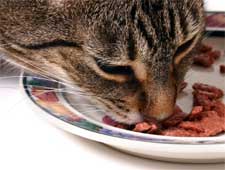 People Food: Additionally, cats have been known to develop a fondness for "people food" such as chicken, bread, French fries, pizza, ice cream, tomato soup, bacon, carrot juice, olives, mushrooms, and carnitas burritos, as well as such cat diet exotica as corn kernels and diced cantaloupe or cantaloupe skin. A diet consisting of people food or unlimited access to normal cat food often leads to the cat becoming obese. This may lead to several health complications, such as diabetes, especially in neutered males. Such health conditions can be prevented through diet and exercise (playing), especially for cats living exclusively indoors. People Food: Additionally, cats have been known to develop a fondness for "people food" such as chicken, bread, French fries, pizza, ice cream, tomato soup, bacon, carrot juice, olives, mushrooms, and carnitas burritos, as well as such cat diet exotica as corn kernels and diced cantaloupe or cantaloupe skin. A diet consisting of people food or unlimited access to normal cat food often leads to the cat becoming obese. This may lead to several health complications, such as diabetes, especially in neutered males. Such health conditions can be prevented through diet and exercise (playing), especially for cats living exclusively indoors.
He'll eat anything: Cats can also develop pica. Pica is a condition in which animals chew or eat unusual things such as fabric, plastic or wool. In cats, this is mostly harmless as they do not digest most of it, but can be fatal or require surgical removal if a large amount of foreign material is ingested (for example, an entire sock). It tends to occur more often in Siamese, Burmese, and breeds with these in their ancestry.
Laser Beams: Domestic cats, especially young kittens, are known for their love of string play. Many cats cannot resist a dangling piece of string, or a piece of rope drawn randomly and enticingly across the floor. This well known love of string is often depicted in cartoons 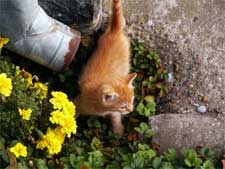 and photographs, which show kittens or cats playing with balls of yarn. It is probably related to hunting instincts, including the common practice of kittens practice hunting of their mother's and each other's tail. If string is ingested, however, it can become caught in the cat’s stomach or intestines, causing illness, or in extreme cases, death. Due to possible complications caused by ingesting a string, string play is sometimes replaced with a laser pointer's dot, which some cats will chase. Some also discourage the use of laser pointers for pet play, however, because of the potential damage to sensitive eyes and/or the possible loss of satisfaction associated with the successful capture of an actual prey object, play or real. and photographs, which show kittens or cats playing with balls of yarn. It is probably related to hunting instincts, including the common practice of kittens practice hunting of their mother's and each other's tail. If string is ingested, however, it can become caught in the cat’s stomach or intestines, causing illness, or in extreme cases, death. Due to possible complications caused by ingesting a string, string play is sometimes replaced with a laser pointer's dot, which some cats will chase. Some also discourage the use of laser pointers for pet play, however, because of the potential damage to sensitive eyes and/or the possible loss of satisfaction associated with the successful capture of an actual prey object, play or real.
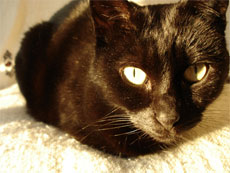 Beware of Cats: Because of their small size, domestic cats pose almost no danger to humans — the main hazard is the possibility of infection (e.g., cat scratch disease, or, rarely, rabies) from a cat bite or scratch. Cats can also potentially inflict severe scratches or puncture an eye, though this is quite rare. Dogs have been known to be blinded by cats in fights, in which the cat specifically targeted the eyes of the larger animal with some accuracy. Beware of Cats: Because of their small size, domestic cats pose almost no danger to humans — the main hazard is the possibility of infection (e.g., cat scratch disease, or, rarely, rabies) from a cat bite or scratch. Cats can also potentially inflict severe scratches or puncture an eye, though this is quite rare. Dogs have been known to be blinded by cats in fights, in which the cat specifically targeted the eyes of the larger animal with some accuracy.
Cats can be destructive to ecosystems in which they are not native and whose species have not had time to adapt to their introduction. In some cases, cats have contributed to or caused extinctions -— for example, see the case of the Stephens Island Wren.
Poison Control Hotline: The liver of a cat is less effective at detoxification than those of humans or dogs, which limits the use of pesticides and medications where they may be exposed. For instance, the common painkiller, paracetamol, is extremely toxic to cats. Because they naturally lack enzymes needed to digest it, even minute portions of doses safe for humans can be fatal. Any suspected ingestion warrants immediate veterinary 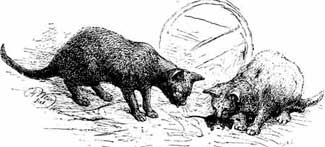 attention. Similarly, phenol based products often used for cleaning and disinfecting, such as Pine-Sol, Lysol, hexachlorophene, etc., are more toxic to cats than to humans or dogs, and exposure has been known to be fatal. attention. Similarly, phenol based products often used for cleaning and disinfecting, such as Pine-Sol, Lysol, hexachlorophene, etc., are more toxic to cats than to humans or dogs, and exposure has been known to be fatal.
Many human foods are toxic to cats; chocolate, for example, can be fatal due to the presence of theobromine (see theobromine poisoning), although few cats will eat chocolate.
All text is available under the terms
of the GNU Free Documentation License
|
